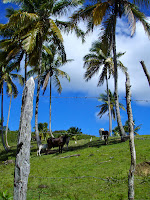With our time in the Dominican Republic coming swiftly to an end, Matteson and I worried our chances to experience the widely popular waterfalls in the mountains of Limon were becoming unlikely.
Fortunately, Library founder Jose Bourget and his wife sensed the panic in our voice as we repeatedly expressed our desire to hike the falls before taking off for home. We tried to sound cool and suave, but let’s be honest. If you know us, you know we’re not good hiding our feelings.
And sure, we could have gone alone, but Jose made it clear the price alone was $50/person, but to travel with him, as a Dominican, would only cost us $10. With little extra to spend, the wait was worth it.
Finally on Sunday morning Jose, Annette, and their two children (Ana-Evelynn and Kiran) picked us up in their truck for a bumpy, dangerously curvy ride through the mountains of Limon. We picked up two exuberant German girls on the way – Leah and Coco – and they rode with long, terrified expressions in the back of the truck. We arrived at the house of Senora Josefina, an elderly widow who lost her leg years ago to infection, has too many children and grandchildren to count, and owns a large piece of farm land where they have established hiking paths to the falls. The house and barn shared land with chickens and pigs running wild, an oversized rooster strutting the property, and a mean dog that three-year-old Ana-Evelynn could not stop smooching. Through the chaos we followed Jose into Senora Josefina’s home where they greeted one another as old friends. Apparently he has been using her services to the falls for nearly six years now.
Offered by the business of Senora Josefina are: Horses to ride the trails, a tour guide for each horse, muddy, wonderfully slick paths to the falls, and at the end of the excursion a traditional Dominican Republic meal.
Annette and Ana-Evelynn rode one horse and Kiran rode another to the falls while the rest of us opted to hike. Some warned us the hike would be incredibly difficult, others described it as a piece of cake. With history of long, buggy hikes in our past, we chanced for an easy walk, overestimated our strength and opted to travel “a pie”, Spanish for “by foot”.
Good news, the hike was a cinch. Four hills, two creeks and 45 minutes later we were at the first of the falls, overwhelmed by the chilled air and beauty of it all. Two minutes later our group of eight had stripped to suits and were swimming over jagged rocks to the falls, then to the cave beyond.
The next fall was larger, with men charging entrance at the top. The stairwell down was actually just an extremely dangerous length of boulders assembled to slightly resemble a stairwell. It took nearly 20 minutes to ascend the steep stairs as it wrapped rock next to the incredibly large waterfall. I’d guess its height measured 200 hundred meters, but you can check with Rick Steves to be sure.
We swam in the falls for hours, back and forth, with the current and against, like little kids at a water park. There were places for high jumps, too, and smaller falls to explore. The smaller falls were only accessible after crossing the larger by a path of slick rocks a few inches below water, keeping balance with a rope tied between trees.
Our excursion was everything we had hoped for. We left the falls chilled and exhausted. Ending our trip at Senora Josefina’s, we sat down to an incredible meal. The fried yucca tasted like an improved potato wedge. We also had fried, salted plantains, a fresh avocado and tomato salad, savory chicken and a mix of rice and beans. All washed down with a cold Presidente and we were satisfied. Our muscles worked, our eyes droopy and our stomachs full, we sat for another hour sipping coffee from Senora Josefina’s farm. In a cup made for espresso shots – no room for milk – the coffee was dark, thick, and delicious. Turns out everything from our meal but the Presidente was planted and raised on Senora Josefina’s farmland. Jose pointed out her field of almond trees, grapefruit, plantains, coffee beans, cocoa plants, sugar canes, avocados, and so forth. And that chicken we enjoyed was the one we had stepped over earlier upon our arrival.












